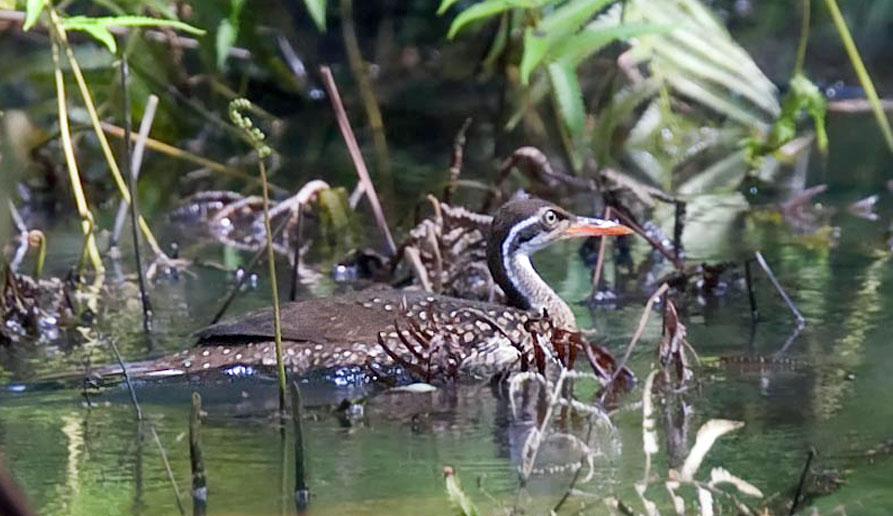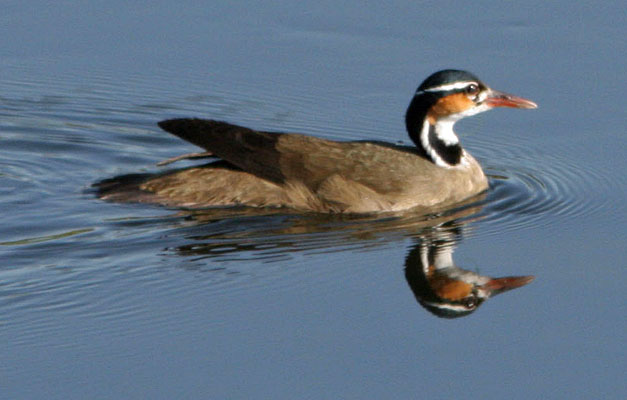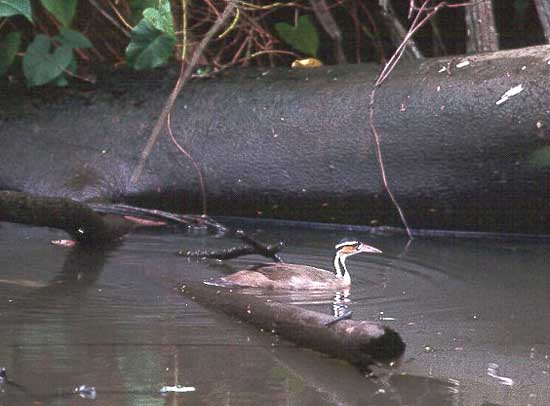
a web page by Don Roberson |
FINFOOTS & SUNGREBE Heliornithidae |
|
|
All species in this family have lobed feet — an adaptation for aquatic life — and feed primarily from the water by taking food items (crustaceans, amphibians, or invertebrates fallen into the water) at the surface (Bertrand 1996). |
The Sungrebe frequents quiet backwaters along freshwater streams and rivers from Mexico to Argentina, but it is local and uncommon throughout its rage (Marc Fenner took this photo, right, in Costa Rica). Sungrebe sometimes found in the same habitat as Sunbittern, which shares a vaguely similar facial pattern (see Sunbittern page), but is in an entirely different Order. Genetic data confirm the parameters of the traditional family Heliornithidae, but these data suggest that Heliornithidae is nested within Rallidae, with the African flufftails (Sarothrura) sister to "Heliornithidae" ((Fain et al. 2007, Hackett et al. 2008). More research is needed. |
There are two finfoots in the Old World. African Finfoot — traditionally called "Peter's Finfoot" in southern Africa — ranges widely throughout tropical and southern Africa but is nowhere common. I've seen it in Uganda but before digital photography. Arthur Grosset photographed this African Finfoot (below) in Ghana. Masked Finfoot Heliopais personata is a poorly known species from southeast Asia. It has become so scarce that it is listed now as Endangered. All finfoots are primarily resident, but Masked Finfoot has an odd distribution of records in Peninsular Malaysia and Sumatra that suggests migratory movement. |
 |
The lack of much basic information extends to all members in the group. In writing about this family, Bertrand (1996) says that "rather few bird families are as poorly known and as infrequently observed as the Heliornithidae." In my brief experience the birds were shy and seen for only a brief time. Young African Finfoots are born precocial and ready to swim, but baby Sungrebes are born blink, almost naked, and helpless. The Sungrebe is already very strange in having a very short incubation period (10–11 days, matching some small passerines) but has an astonishing behavior entirely unique in the bird world: the male Sungrebe is able to transport these helpless offspring, even in flight! Bertrand (1996) explains:
Yes, Sungrebe and the finfoots are mystery birds indeed. |
Photos: The swimming Sungrebe Heliornis fulica was in the Brazilian Pantanal, in March 2007. Marc Fenner photographed his Sungrebe at Tortuguero, Costa Rica, in March 1991. Arthur Grosset photographed the African Finfoot Podica senegalensis in Ghana in May 2011. All photos © Don Roberson, except the photos credited © Marc Fenner and © Arthur Grosset, and used with permission; all rights reserved. Bibliographic note: There is no "family book" but a fine introduction, with excellent photos, is in Bertrand (1996). Literature cited:
|
 The Heliornithidae is a small family of odd aquatic birds locally distributed in the tropics around the world. There are three species — each in a monotypic genus — and each fills a niche in the major tropical regions of the world. Both species in the Old World are called Finfoots; the single example in the New World is named Sungrebe (left). Don't be fooled by the name "Sungrebe." These are not remotely related to grebes but are most closely related to rails.
The Heliornithidae is a small family of odd aquatic birds locally distributed in the tropics around the world. There are three species — each in a monotypic genus — and each fills a niche in the major tropical regions of the world. Both species in the Old World are called Finfoots; the single example in the New World is named Sungrebe (left). Don't be fooled by the name "Sungrebe." These are not remotely related to grebes but are most closely related to rails. 